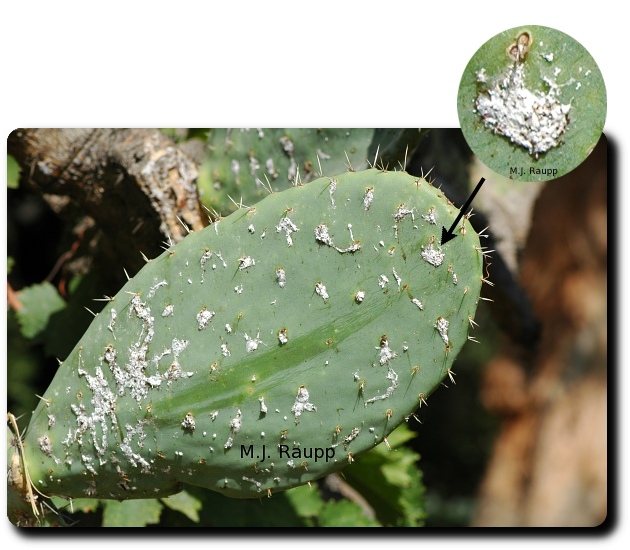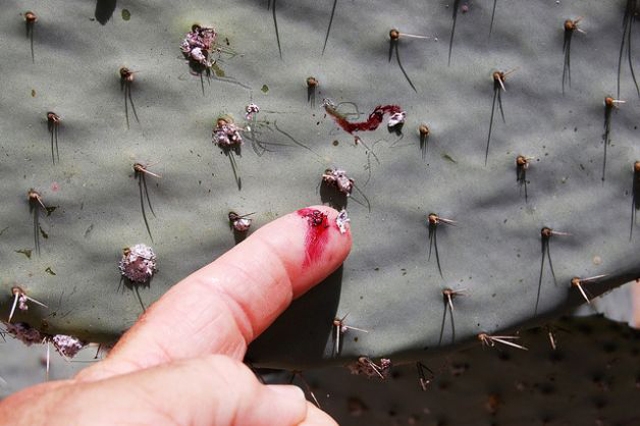By Andrea Peck
A blond in a red dress can do without introductions – but not without a bodyguard.
-Rona Jaffe
From afar, cochineal scale may look like a fungus or mold that has infected your prickly pear or nopal cactus (opuntia). If the pest takes up a small space, you may write the damage off to a bit of dead tissue, something that you might lop off if you are industrious and in possession of armor.
But, make no mistake, cochineal scale is a small insect. The female is usually what you see on your plant – she lives out her life, breeding and eating on the cactus, while the male, blessed with wings, takes flight on insect adventures. Juveniles are mobile enough. Once settled on a feeding spot, they produce long wax filaments. Soon they move to the edge of the cactus pad and are taken by the wind in the hopes of landing on unchartered territory. The female stays put.
This is no pretty bug. But, her power is fierce.
Underneath that unexceptional appearance lies a chemical – carmine – which, when eaten tastes bitter. This is her defense, since clearly she is defenseless lying atop a plant that grows in a desert climate without the ability to flee. What's a lady to do besides resorting to chemicals? She has her devices.
But, scratch beneath the surface (literally) and you have a grander tale of carmine and color. Carmine may be bitter to the taste, but it is candy to the eye. And if you are facile in collecting the creature, you know that it produces a rich red color that can be permutated into many shades, from pink to deep maroon. Its useful origins trace back to the Aztecs. The Spaniards eventually got a hold of it. From there it became a hot commodity. The British were said to hire pirates to confiscate gold and valuables – and cochineal insects – from aboard ships. The famous British red coat was colored with the cochineal. Betsy Ross herself used the insect dye to color the red stripes of our first flag. Art of all kinds utilized it.
The 1900's brought synthetic dyes and cochineal went out of fashion for a while. This did not last long. Synthetic dyes, it turns out, were carcinogenic.
The dye continues to be useful despite some relatively recent uproar about bugs in our foods. It was probably not a pretty sight when mothers around the country discovered that their red velvet cupcakes had bugs in them.
Their worry is not completely unfounded, however, as some cases of anaphylactic reactions and asthma has been attributed to the dye. The FDA did concede to pressure by requiring food products to be labeled. You have to read your labels carefully, however. Any number of names may stand in for carmine. (Carmine, cochineal extract, Red 4 and E120 are a few that I have come across).
Foods that are red or pink, such as yogurt, ice cream, candy and juice may contain the insect. Interestingly, cochineal is considered one of the few safe ingredients in eye cosmetics and is used in almost all types of cosmetic products.
The cochineal scale is a testament to the power of insects. Maybe its cardinal color is no accident. The color red, a symbol of love and hate, power and courage has had an honored place in history. Who knew that a lowly bug was responsible?
Below is a great video which shows the process of dying wool.
http://www.youtube.com/watch?v=2k_FJoaOQGA
Also, there is an entire book devoted to the subject:
A Perfect Red by Amy Butler Greenfield

